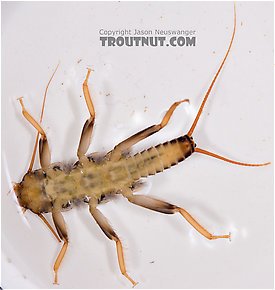Blog & Latest Updates
Fly Fishing Articles
Insects by Common Name


> > Hate to do this again....
The Specimen
The Discussion
| PeterO | June 6th, 2007, 7:58 am | |
| Posts: 8 | Jason- This is actually a specimen of Acroneuria abnormis. Paragnetina species have a complete set of spinules/setae on the occiput, which this guy is lacking. On a semi-related subject, could you forward me the collection data for the Arcynopteryx paralella you got from the Catskills? Thanks a bunch. | |
| GONZO | June 6th, 2007, 8:15 am | |
Site Editor "Bear Swamp," PAPosts: 1681 | Thanks, Peter. The ID mistake was mine, not Jason's. When he collected this specimen, I took a quick glance at it and assumed it was P. immarginata (which is one of the more common of the highly marked "golden stones" in the Poconos). When I returned to see his close-up pictures, I noticed the difference in the dorsal markings and realized I had made a hasty judgment. | |
| Troutnut | June 6th, 2007, 8:28 am | |
Administrator Bellevue, WAPosts: 2737 | Thanks for the correction, Peter. I'll get you that Arcynopteryx info. Gonzo, I guess I can forgive you... ;) Really, thanks for showing me to that collecting spot! I got the first Cinygmula nymph I've collected, so it was worth it for that, among other things. | |
| Jason Neuswanger, Ph.D. Troutnut and salmonid ecologist | ||
| GONZO | June 6th, 2007, 8:59 am | |
Site Editor "Bear Swamp," PAPosts: 1681 | Jason, The forgiveness is appreciated, although it also means that we failed to collect a P. immarginata specimen for your site. But, the Cinygmula was a revelation to me as well. And I'm still trying to figure out why we found mature D. lata (cornuta) nymphs two weeks before they normally emerge in that stretch. That little stream was abnormally low and warm, but I'm not sure that accounts for the difference. | |
| Huckleberry | October 1st, 2010, 8:02 am | |
| Williamsburg, VA Posts: 1 | Hey guys, I don't see a cercal fringe, even in the closeups. As you know, this is a key characteristic of Acroneuria, sp. Could it be blending in with the white background? I'm not all that familiar with abnormis. Clue me in. Thanks. | |
| GONZO | October 1st, 2010, 12:21 pm | |
Site Editor "Bear Swamp," PAPosts: 1681 | Could it be blending in with the white background? Yes. If you click on the full size view of photo #9, you can make out a fine faint fringe of long hairs along the inside edges of the cerci. In photo #5, the (whitish) fringe along the inside of the right cercus partially obscures part of the hook. In general appearance, A. abnormis nymphs lack anal gill tufts and tend to have broadly concolorous (dark) tergites and femora instead of the narrower dark abdominal banding and leg bands often found in sympatric species like lycorias or carolinensis. The pale band across the back of the head also tends to be more narrowly linear. | |
Quick Reply
You have to be logged in to post on the forum. It's this easy:
Related Discussions
| Title | Replies | Last Reply |
| Acroneuria specimen moved from genus to species level In Acroneuria carolinensis Stonefly Nymph by Entoman | 0 | |
| Re: Acroneuria In Paragnetina media Stonefly Larva by GONZO | 3 | Mar 11, 2012 by Entoman |
| Re: Lots of new specimens today (June 4th) from PA In General Discussion by Troutnut | 8 | Jun 5, 2007 by Dinerobyn |
| Re: Need help Identifying this please ? In the Identify This! Board by Btbo32 | 4 | Nov 19, 2017 by Btbo32 |
| Distance between the eyes of male Epeorus In the Mayfly Genus Epeorus by Troutnut | 0 | |
| Re: Interesting clinger species In the Identify This! Board by CalebBoyle | 7 | Mar 31, 2007 by GONZO |
| Moved to Acroneuria lycorias In Acroneuria lycorias Stonefly Nymph by Entoman | 0 | |
| Re: Which species is this? In Acroneuria abnormis Stonefly Nymph by Troutnut | 4 | Mar 11, 2012 by Entoman |
| Re: Yakima River Light Cahill In the Identify This! Board by Drywaters | 6 | Dec 20, 2016 by Troutnut |
| Re: some northcentral penna. stoneflies In the Identify This! Board by Gutcutter | 4 | May 2, 2010 by SlateDrake9 |
Troutnut.com is copyright © 2004-2024 Jason
Neuswanger (email Jason). See my FAQ for information about use of my images.
 privacy policy
privacy policy


